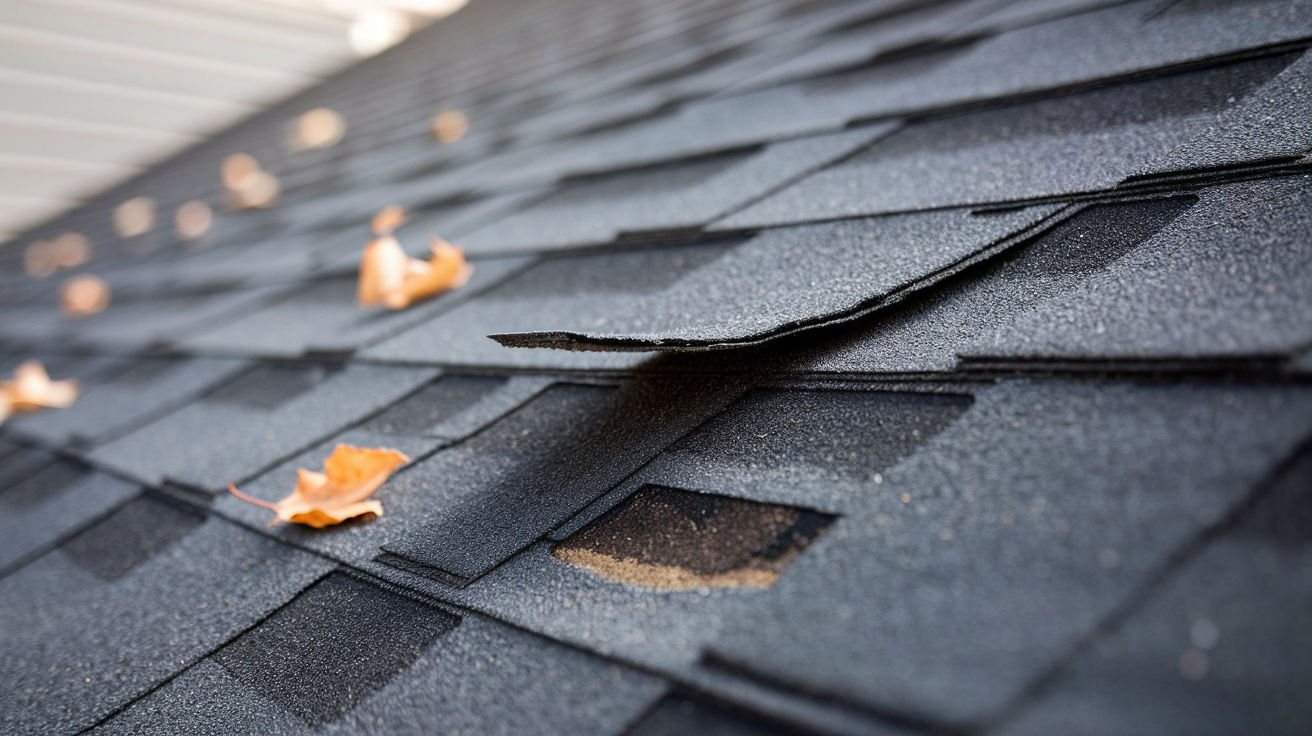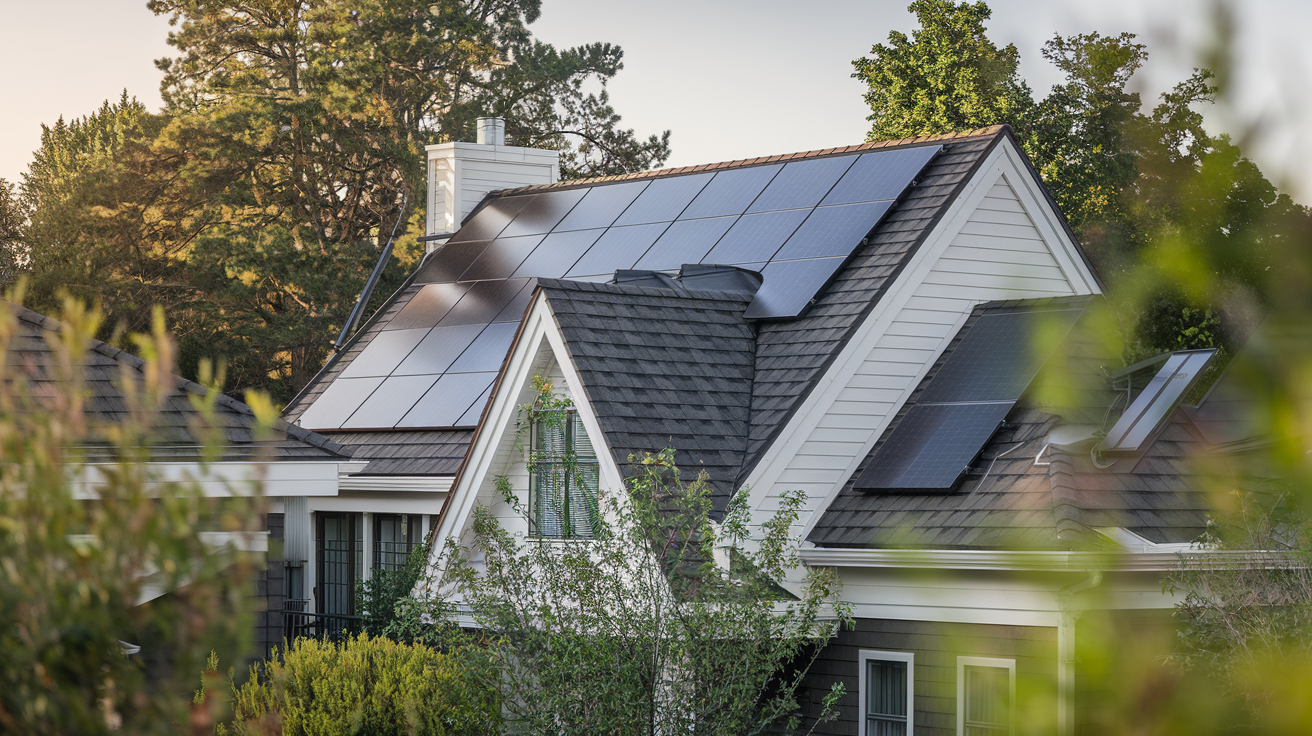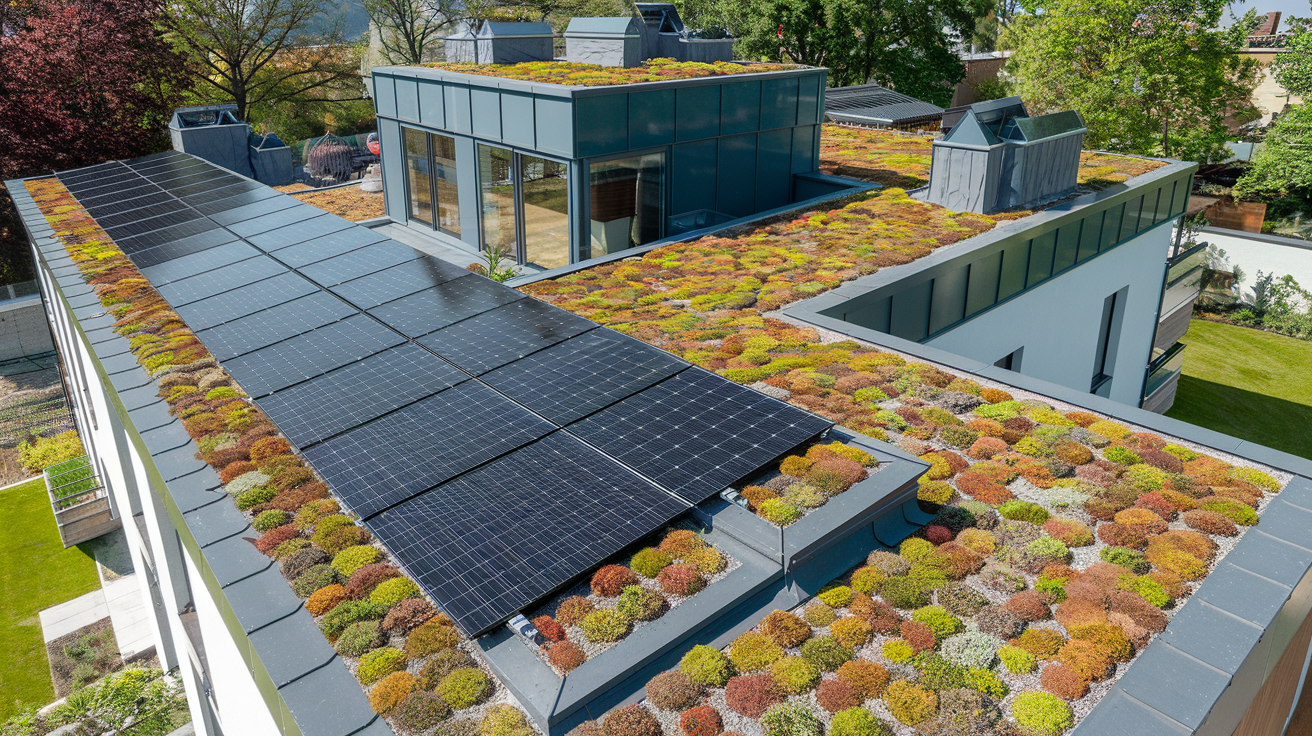Save Up to 40% on Energy Bills: Expert Guide to Roof Efficiency
Is your monthly energy bill higher than it should be? Your roof might be the hidden culprit. The average American household spends over $2,000 annually on energy bills, with up to 25% of that heat loss occurring through the roof (Source: U.S. Department of Energy). This invisible drain on your wallet doesn't just affect your comfort—it impacts your bottom line every month.
Think of your roof as your home's helmet: when it's not doing its job properly, everything underneath becomes vulnerable. Whether you're dealing with skyrocketing summer cooling costs or winter heating bills that make you cringe, understanding the roof-energy connection is crucial for any homeowner looking to reduce their energy consumption and save money.
In this comprehensive guide, you'll discover how your roof affects your energy bills, practical solutions for improving efficiency, and smart investments that can lead to significant savings. From choosing the right materials to implementing proper ventilation strategies, we'll explore proven methods to optimize your roof's energy performance and reduce your monthly expenses.
- Understanding the Roof-Energy Connection
- Identifying and Addressing Energy Efficiency Issues
- Climate-Specific Roofing Solutions
- Cost and Benefits of Energy-Efficient Roofing
- Choosing the Right Professionals for Your Roofing Needs
Understanding the Roof-Energy Connection
Your roof plays a vital role in your home's energy efficiency, offering more than just protection from the elements. A well-designed and properly installed roof can significantly lower your energy bills and improve your home's comfort. Conversely, an inefficient roof can lead to substantial energy loss, increasing your heating and cooling costs. Understanding this connection is key to making smart decisions about roof improvements and energy conservation.

How Your Roof Affects Energy Efficiency
Your roof's impact on energy efficiency depends on several factors: insulation, ventilation, and reflectivity.
Insulation
Proper insulation minimizes heat transfer between the inside and outside of your home, maintaining a consistent indoor temperature and reducing the workload on your heating and cooling systems (source: U.S. Department of Energy). Insulation effectively adds resistance to heat flow, keeping warm air in during winter and out during summer, leading to lower energy bills and a more comfortable living environment. Consider getting a roof assessment to determine the effectiveness of your current insulation.
<div class="table_criteria" style="display: flex; flex-direction: column; width: 100%; max-width: 600px; margin: auto;">
<table style="width: 100%; border-collapse: collapse;">
<thead>
<tr>
<th style="border: 1px solid #ddd; padding: 8px; background-color: #f2f2f2;">Insulation Type</th>
<th style="border: 1px solid #ddd; padding: 8px; background-color: #f2f2f2;">R-Value</th>
<th style="border: 1px solid #ddd; padding: 8px; background-color: #f2f2f2;">Benefits</th>
</tr>
</thead>
<tbody>
<tr>
<td style="border: 1px solid #ddd; padding: 8px;">Fiberglass</td>
<td style="border: 1px solid #ddd; padding: 8px;">2.2 - 2.7 per inch</td>
<td style="border: 1px solid #ddd; padding: 8px;">Cost-effective and easy to install</td>
</tr>
<tr>
<td style="border: 1px solid #ddd; padding: 8px;">Spray Foam</td>
<td style="border: 1px solid #ddd; padding: 8px;">3.5 - 6.5 per inch</td>
<td style="border: 1px solid #ddd; padding: 8px;">Provides air seal and high R-value</td>
</tr>
<tr>
<td style="border: 1px solid #ddd; padding: 8px;">Cellulose</td>
<td style="border: 1px solid #ddd; padding: 8px;">3.2 - 3.8 per inch</td>
<td style="border: 1px solid #ddd; padding: 8px;">Eco-friendly and good coverage</td>
</tr>
</tbody>
</table>
</div>Ventilation
Proper ventilation is crucial for a balanced and energy-efficient roofing system. It works in tandem with insulation, allowing hot air to escape during summer and preventing moisture buildup in winter. Excess moisture can reduce insulation effectiveness, forcing your heating system to work harder (source: U.S. Department of Energy). While crucial, ventilation needs careful balancing with insulation to prevent excessive heat loss in winter. Learn more about roof maintenance to understand the importance of balanced ventilation.
Reflectivity
Reflectivity, the amount of sunlight your roof reflects, is another important factor. Cool roofs, designed for higher reflectivity, absorb less solar heat, leading to lower cooling costs in hot weather. Studies show cool roofs can lower roof surface temperatures by 4–12 °C. However, this high reflectivity can increase heating demand in colder climates.
<div class="table_criteria" style="display: flex; flex-direction: column; width: 100%; max-width: 600px; margin: auto;">
<table style="width: 100%; border-collapse: collapse;">
<thead>
<tr>
<th style="border: 1px solid #ddd; padding: 8px; background-color: #f2f2f2;">Roof Type</th>
<th style="border: 1px solid #ddd; padding: 8px; background-color: #f2f2f2;">Reflectivity</th>
<th style="border: 1px solid #ddd; padding: 8px; background-color: #f2f2f2;">Ideal Climate</th>
</tr>
</thead>
<tbody>
<tr>
<td style="border: 1px solid #ddd; padding: 8px;">Cool Roof</td>
<td style="border: 1px solid #ddd; padding: 8px;">High</td>
<td style="border: 1px solid #ddd; padding: 8px;">Hot Climates</td>
</tr>
<tr>
<td style="border: 1px solid #ddd; padding: 8px;">Green Roof</td>
<td style="border: 1px solid #ddd; padding: 8px;">Moderate</td>
<td style="border: 1px solid #ddd; padding: 8px;">Urban Areas</td>
</tr>
<tr>
<td style="border: 1px solid #ddd; padding: 8px;">Metal Roof</td>
<td style="border: 1px solid #ddd; padding: 8px;">Variable</td>
<td style="border: 1px solid #ddd; padding: 8px;">Mixed Climates</td>
</tr>
</tbody>
</table>
</div>Key Statistics on Energy Loss Through Roofs
Roofs contribute significantly to a building's energy loss. According to the U.S. Department of Energy, roofs can account for up to 25% of total heat loss in homes. This means about a quarter of your heating costs could be going through your roof. The U.S. Department of Energy further states that 50% of residential heating costs come from heat escaping through the roof, walls, and foundation combined.

Impact of Roof Condition
A sagging roof deck, the layer beneath shingles and insulation, can indicate structural issues that may worsen energy loss. Addressing these structural problems is crucial for both energy efficiency and the overall integrity of your home.
Energy-Efficient Roofing Solutions
Investing in energy-efficient roofing options, like cool or green roofs, offers substantial energy savings. Studies show cool roofs can reduce annual energy consumption by almost 20% during peak summer. Green roofs provide added insulation and reduce temperature fluctuations, leading to lower energy usage.
<div class="table_criteria" style="display: flex; flex-direction: column; width: 100%; max-width: 600px; margin: auto;">
<table style="width: 100%; border-collapse: collapse;">
<thead>
<tr>
<th style="border: 1px solid #ddd; padding: 8px; background-color: #f2f2f2;">Roof Type</th>
<th style="border: 1px solid #ddd; padding: 8px; background-color: #f2f2f2;">Energy Savings</th>
<th style="border: 1px solid #ddd; padding: 8px; background-color: #f2f2f2;">Additional Benefits</th>
</tr>
</thead>
<tbody>
<tr>
<td style="border: 1px solid #ddd; padding: 8px;">Cool Roof</td>
<td style="border: 1px solid #ddd; padding: 8px;">Up to 20% annually</td>
<td style="border: 1px solid #ddd; padding: 8px;">Reduces cooling costs</td>
</tr>
<tr>
<td style="border: 1px solid #ddd; padding: 8px;">Green Roof</td>
<td style="border: 1px solid #ddd; padding: 8px;">2.2% or more</td>
<td style="border: 1px solid #ddd; padding: 8px;">Adds insulation</td>
</tr>
<tr>
<td style="border: 1px solid #ddd; padding: 8px;">Metal Roof</td>
<td style="border: 1px solid #ddd; padding: 8px;">Up to 40% annually</td>
<td style="border: 1px solid #ddd; padding: 8px;">Reflective and durable</td>
</tr>
</tbody>
</table>
</div>Energy Savings and Incentives
In Climate Zone 5, an energy-efficient roof (R-30) can lead to annual whole-building energy savings of 6-9%. Highly reflective metal roofs can offer even more substantial savings, up to 40% annually. Financial incentives like the Energy-Efficient Home Improvement Tax Credit can further offset the cost of upgrades, offering up to 30% of qualifying roofing material costs, with a maximum credit of $1,200 per year.
Identifying and Addressing Energy Efficiency Issues
Understanding the energy efficiency issues related to your roof can significantly lower your home's energy bills. Roofs account for about 25% of total heat loss in buildings, making them a key factor in overall energy efficiency. Identifying common signs of energy loss and addressing problems with insulation and ventilation can help you make smart choices to improve your home's energy performance.
Recognizing the signs of energy loss from your roof is the first step towards better energy efficiency. One sign is a sudden increase in your heating or cooling bills. If you see your energy costs rising, heat escaping through your roof might be the culprit. For example, unusually high winter heating bills could mean your roof isn't keeping the heat inside. Sometimes, improving insulation or ventilation is enough.
Uneven Temperatures and Drafts
Another sign is uneven temperatures throughout your house. Some rooms might be much colder or warmer than others. This could be between floors or even rooms on the same floor, often pointing to poor insulation or problems with ventilation. Drafts, especially near upstairs windows and doors, can also signal gaps in insulation or sealing.
Moisture Buildup
Moisture in the attic is another warning sign. This usually means warm, moist air is escaping into the attic and condensing. If you notice this, it's time to check your roof's energy performance. Consider a roof assessment to identify potential problem areas.
Problems with Insulation and Ventilation
Insulation and ventilation are crucial for an energy-efficient home. Poor insulation lets heat escape in the winter and enter in the summer, raising your energy bills. The U.S. Department of Energy says proper attic insulation can cut energy bills by 10% to 50%.
<div class="table_criteria" style="display: flex; flex-direction: column; width: 100%; max-width: 600px; margin: auto;">
<table style="width: 100%; border-collapse: collapse;">
<thead>
<tr>
<th style="border: 1px solid #ddd; padding: 8px; background-color: #f2f2f2;">Problem</th>
<th style="border: 1px solid #ddd; padding: 8px; background-color: #f2f2f2;">Solution</th>
<th style="border: 1px solid #ddd; padding: 8px; background-color: #f2f2f2;">Impact</th>
</tr>
</thead>
<tbody>
<tr>
<td style="border: 1px solid #ddd; padding: 8px;">Poor Insulation</td>
<td style="border: 1px solid #ddd; padding: 8px;">Upgrade insulation</td>
<td style="border: 1px solid #ddd; padding: 8px;">Reduces heat loss/gain</td>
</tr>
<tr>
<td style="border: 1px solid #ddd; padding: 8px;">Inadequate Ventilation</td>
<td style="border: 1px solid #ddd; padding: 8px;">Improve airflow</td>
<td style="border: 1px solid #ddd; padding: 8px;">Prevents moisture buildup</td>
</tr>
<tr>
<td style="border: 1px solid #ddd; padding: 8px;">Air Leaks</td>
<td style="border: 1px solid #ddd; padding: 8px;">Seal gaps</td>
<td style="border: 1px solid #ddd; padding: 8px;">Enhances energy efficiency</td>
</tr>
</tbody>
</table>
</div>Importance of Ventilation
Ventilation is just as important. Poor ventilation leads to moisture buildup, damaging your roof and reducing its insulation. Good attic ventilation lets warm, moist air escape, preventing condensation and the growth of mold and rot. Effective ventilation regulates temperature and moisture, preventing damage and improving energy efficiency.
Solutions for Air Leaks and Structural Damage
Fixing air leaks and structural damage significantly boosts your roof's energy efficiency. Air leaks often appear around chimneys, skylights, and roof edges. Sealing these leaks with caulk or weatherstripping stops unwanted air exchange and reduces energy loss.
Structural Damage and Material Choices
Structural damage, like missing shingles or damaged flashing, weakens your roof. Regular roof inspections and quick repairs protect your roof against energy loss. Investing in energy-efficient roofing materials offers long-term savings.
Energy-Efficient Roofing Options
Cool roofs reflect sunlight and reduce heat absorption. Green roofs use plants for extra insulation and cooling. Metal roofs, for instance, are highly reflective, lowering energy costs. These solutions improve energy efficiency and extend the life of your roof. For a personalized evaluation, consider a roof assessment.
Climate-Specific Roofing Solutions
Understanding the relationship between your roof and your home's energy bills is crucial for a more energy-efficient home. Choosing the right roofing solution for your climate is one of the most effective ways to improve this efficiency.
Roofing Material Recommendations by Climate Zone
Choosing the right roofing material for your climate zone is key to maximizing energy efficiency.
Hot Climates
In hot, sunny areas, cool roofs are highly recommended. Cool roofs reflect more sunlight and absorb less heat, keeping the inside of your home cooler and reducing cooling costs. Studies show cool roofs can lower annual energy savings in the summer by up to 20% and peak energy savings by up to 27%.
Cold Climates
For colder climates, low-emissivity roofs are beneficial. These roofs add resistance to heat flowing out of the building, saving on heating energy.
Mixed Climates
What if you have both hot summers and cold winters? Metal roofs are a good option. Known for their high reflectivity and thermal resistance, metal roofs can offer annual energy cost savings of up to 40%.

Long-Term Performance
Remember, aging and weathering can affect any roofing material's solar reflectance. A regular roof assessment can help identify potential issues and maintain optimal energy efficiency.
Ventilation Strategies for Different Climates
Proper roof ventilation is another important factor in improving energy efficiency across different climates.
Hot Climates
In hot climates, good attic ventilation prevents heat buildup, reducing the need for air conditioning and lowering energy bills.
Cold Climates
In colder areas, ventilation needs to balance moisture control and energy conservation. Too much ventilation can cause heat loss, while too little can cause moisture buildup.
Ventilation Best Practices
Understanding your climate's specific ventilation needs improves energy efficiency and home comfort. Building codes often require one square foot of free vent area for every 150 square feet of ceiling.
Cost and Benefits of Energy-Efficient Roofing
Investing in energy-efficient roofing can significantly influence your home's energy bills and environmental footprint. Energy-efficient roofs offer immediate energy savings and contribute to your home's overall value.
Typical Cost Ranges for Energy-Efficient Roofing Options
The initial cost of energy-efficient roofing materials varies depending on the type and installation complexity.
Asphalt Shingles
Asphalt shingles are known for their affordability and a typical lifespan of 20 to 30 years. They typically cost between $1.50 and $5.50 per square foot.
Metal Roofs
Metal roofs offer high energy efficiency due to their reflectivity, but have a higher initial cost. Metal roofing prices generally start around $5.50 per square foot and can increase based on the type and finish.
Cool Roofs and Green Roofs
Cool roofs and green roofs may have higher upfront costs but offer substantial long-term energy savings. Cool roofs are designed to reflect more sunlight and absorb less solar energy. Green roofs are covered with vegetation.
Long-Term Energy Savings and Return on Investment
Energy-efficient roofing offers substantial long-term savings and a compelling return on investment (ROI).
Metal Roofs
Metal roofs can reduce energy costs by up to 40% annually due to their reflectivity and thermal resistance.
Cool Roofs
Cool roofs can save up to 19.8% annually on energy costs, with peak summer savings reaching 27%.
Green Roofs
Studies show green roofs can reduce annual energy consumption by 2.2% or more, offering additional insulation and mitigating the urban heat island effect.
Increased Home Value
A new energy-efficient roof can increase home value, offering a 60% to 85% average ROI depending on the material and durability.
Government Incentives and Rebates
Various government incentives and rebates encourage homeowners to adopt energy-efficient technologies.
Federal Tax Credit
The Energy-Efficient Home Improvement Tax Credit offers homeowners up to 30% of the cost of qualifying roofing materials, capped at $1,200 annually.
State and Local Incentives
Beyond the federal tax credit, explore state and local government rebates and programs. Some utility companies offer rebates for energy-efficient upgrades, including roofing.
Choosing the Right Professionals for Your Roofing Needs
Choosing the right roofing professionals is key for a long-lasting and energy-efficient roof. A properly installed roof significantly impacts your energy bills. Qualified professionals ensure the job is done right the first time, preventing costly repairs later.
Selecting a Qualified Roofing Contractor
Choosing a qualified roofing contractor involves evaluating their experience, reputation, and knowledge of energy-efficient options.
Assessing Experience and Specialization
Years of experience indicate a contractor's ability to handle various projects and problems. Specialization in energy-efficient options like cool or green roofs is a plus if you want to lower energy consumption.
Verifying Licenses and Insurance
A licensed and insured contractor protects you from liabilities and ensures compliance with building codes. Licensed contractors are more likely to follow high standards for quality and safety.
Essential Questions to Ask Potential Contractors
Asking the right questions before hiring helps you evaluate a contractor's suitability.
Inquiring About Previous Projects
Asking about past projects similar to yours gauges a contractor's expertise. Focus on projects involving energy-efficient solutions in similar climates or building types.
Understanding the Scope and Timeline
A clear scope of work and timeline prevents misunderstandings. Get a detailed estimate including materials, labor, and extra costs.
Discussing Warranties and Guarantees
Ask about warranties on materials and workmanship. Reputable contractors offer warranties covering defects and errors. Carefully review the warranty details to understand what's covered and what's not.
By carefully choosing a qualified contractor and asking the right questions, you ensure your roof boosts curb appeal and saves energy. With the right professionals, you can invest confidently in a roof that meets your needs and promotes sustainable living. Explore tax credits for energy-efficient home improvements, which offer up to 30% off qualifying materials, up to $1,200 annually. These credits can offset project costs and make energy-efficient upgrades more affordable.
Disclaimer: This blog post is intended for informational purposes only and should not be considered professional roofing advice. Always consult with qualified roofing contractors and insurance professionals for specific guidance regarding your individual circumstances.
